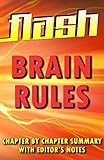Brain Rules: 12 Principles for Surviving and Thriving at Work, Home, and School: Flash Summaries: Chapter by Chapter Summary with Editor’s Notes – in a Flash
ON SALE FOR A LIMITED TIME
Get a summary of Brain Rules by John Medina you can trust – in a flash.
Flash Summaries implements proven techniques to help save time and retain key points and themes. Whether you’re needing a quick refresher or deciding on your next read, Flash Summaries is a summary you can trust:
• Time Saving Techniques
We utilize techniques taken by multilateral industries to condense information concisely down to its essentials. Grab details of importance at a glance.
• Multi-Point Quality Inspection
Multiple quality checkpoint inspections are performed along the way to ensure every summary is the highest caliber on the market. Buy with confidence and enjoy incredible prices lower than ever before.
• Editor’s Notes
A most useful feature and like having a guide by your side, learn from and be taught along the way. We walk you through the book to highlight what is important and notable through our Editor’s Notes.*
• Designed with Book Clubs and Groups in Mind
Not only meant for individuals, but book clubs and groups can also benefit from using Flash Summaries as a tool to share with others. Add to the conversation with group oriented questions to bring hot and notable topics to surface.
Preview summary with editor’s notes:
Chapter Summary
Learning rewires the brain; the structure of our neurons changes as we learn new things, and the brain grows like a muscle when we use certain parts of it a great deal. The number of neural connections in our brain is changing almost constantly, going through periods of particular upheaval when children are about 2 and again during puberty. During these periods, the brain will have 2 or 3 times the number of connections typical of the adult brain, before falling again.
Editor’s Notes:
We are invited to consider a familiar scene – a young boy pretending that a stick is a sword – and uses it to introduce us to the remarkable power of the human brain. The ability to see one thing and understand that it represents another, which the author calls ‘symbolic reasoning’, is what let us develop language, art and culture. It has also been key to our success as a species: interpreting a word or a sign as information about the real world – “This is where the food is”, or “Watch out for that tiger!” – allowed early humans to survive and thrive in dangerous conditions.
Price:


